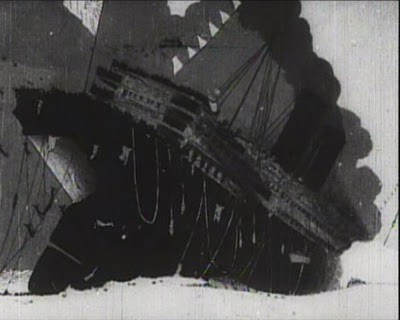 |
| Fig. 1 - Portrait of Winsor McCay (1871 - 1934) |
 |
Fig. 3 - A screen shot from 'How a Mosquito Operates.' (1912) |
'How a Mosquito Operates' was McCay's second animation, he showed that animation could entertain audiences with a simple storyline of a mosquito trying to feed while a man feeds. He explores visual gags that animation can offer such as the mosquito trying to squeeze through the tiny gap in the window on top of the door when in reality they would fly straight through. He also brings charm and character to the insect by giving it a mini brief case and top hat as he lifts his hat to greet the audience (Fig. 3).
 |
| Fig. 2 - Poster for Winsor McCay's Gertie : The Wonderfully Trained Dinosaur (1914.) |
"...McCay combined the lessons of his earlier two films in order to create a character who is animation's first cartoon personality." (L, Rabinovitz, 2011) Moving on from the mosquito in 'How a Mosquito Operates' He created Gertie: The Wonderfully Trained Dinosaur, that is when she does not misbehave during her performance, which wonderfully shows off the personality possibilities animation has to offer. McCay alone produced over 10,000 frames for this feature, each one drawn on to there own sheet of paper including backgrounds, because of animation being in its early stages the use of transparent animation cells had not been developed yet. Cartoon historian Leonard Maltin "For years Gertie had been named in histories as the first animated cartoon. With all its impact, it might as well have been." (Erickson, H) Believable personalities like Gertie's went on to inspire other animators particularly having a great impact on the work of Walt Disney which brought huge success in creating memorable character personalities. Even in today's modern animations a strong character personality is a key componant to creating a successfull outcome and McCay sparked this idea with Gertie.
 |
| Fig. 4 - Screen shot from 'The Sinking of the Lusitania' (1918) |
The style of this animation is done in a documentary style depicting the bombing and sinking of the warship Lusitania. McCay's grapical style becomes almost realistic depicting the horrors of the event that had been described. Again like his previous animations every frame was hand drawn however he used cels animation. Even by todays standards the smoke and the water's waves are impressive and beautifully done. Watching the animation shows similarities reflected in 'Titanic' in a critics review he blieves "...Cameron was at least inspired by some of the images here, particularly the way the life boats lower to the ocean and the images of bodies plummeting off the ship's stern." (Unknown, 2010)
List of Illustrations:
- Fig. 1 - Portrait of Winsor McCay. Online at: http://bearalley.blogspot.com/2009/09/winsor-mccay.html
- Fig. 2 - Poster for Winsor McCay's Gertie : The Wonderfully Trained Dinosaur. Online at: http://www.flickr.com/photos/cabinet/2183157738/
- Fig. 3 - A screen shot from 'How a Mosquito Operates.' Online at: http://www.weirdwildrealm.com/f-winsor-mccay.html
- Fig. 4 - Screen shot from 'The Sinking of the Lusitania' (1918.) Online at: http://animationreview.wordpress.com/tag/winsor-mccay/
Bibliography:
- Erickson, H. AllMovie, Gertie the Dinosaur. http://www.allmovie.com/work/gertie-the-dinosaur-151281 (Accessed 22.03.11)
- Rabinovit, L. (2011) Film Reference, McCay, Winsor. http://www.filmreference.com/Writers-and-Production-Artists-Lo-Me/McCay-Winsor.html (Accessed 20.03.11)
- Unknown (2010). 100 Years of Movies. http://100yearsofmovies.blogspot.com/2010/09/sinking-of-lusitania-1918.html. (Accessed 22.03.11)

No comments:
Post a Comment